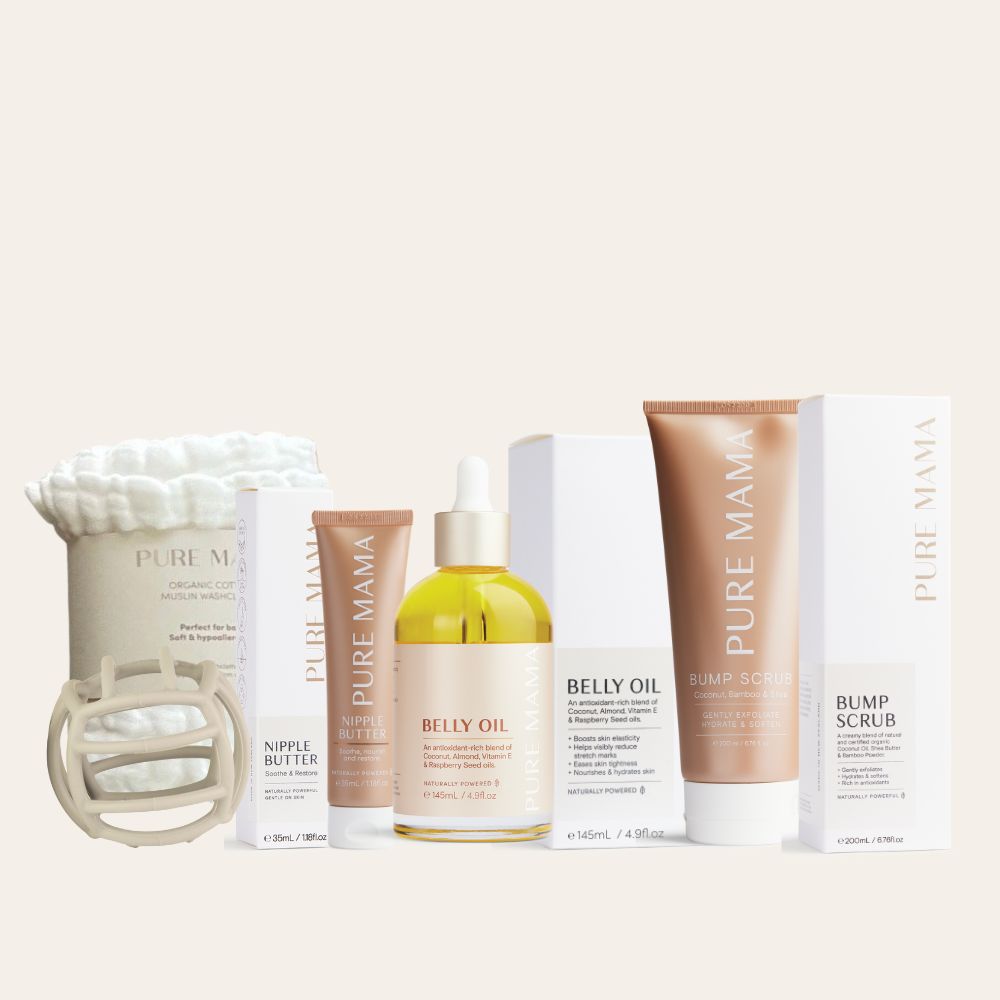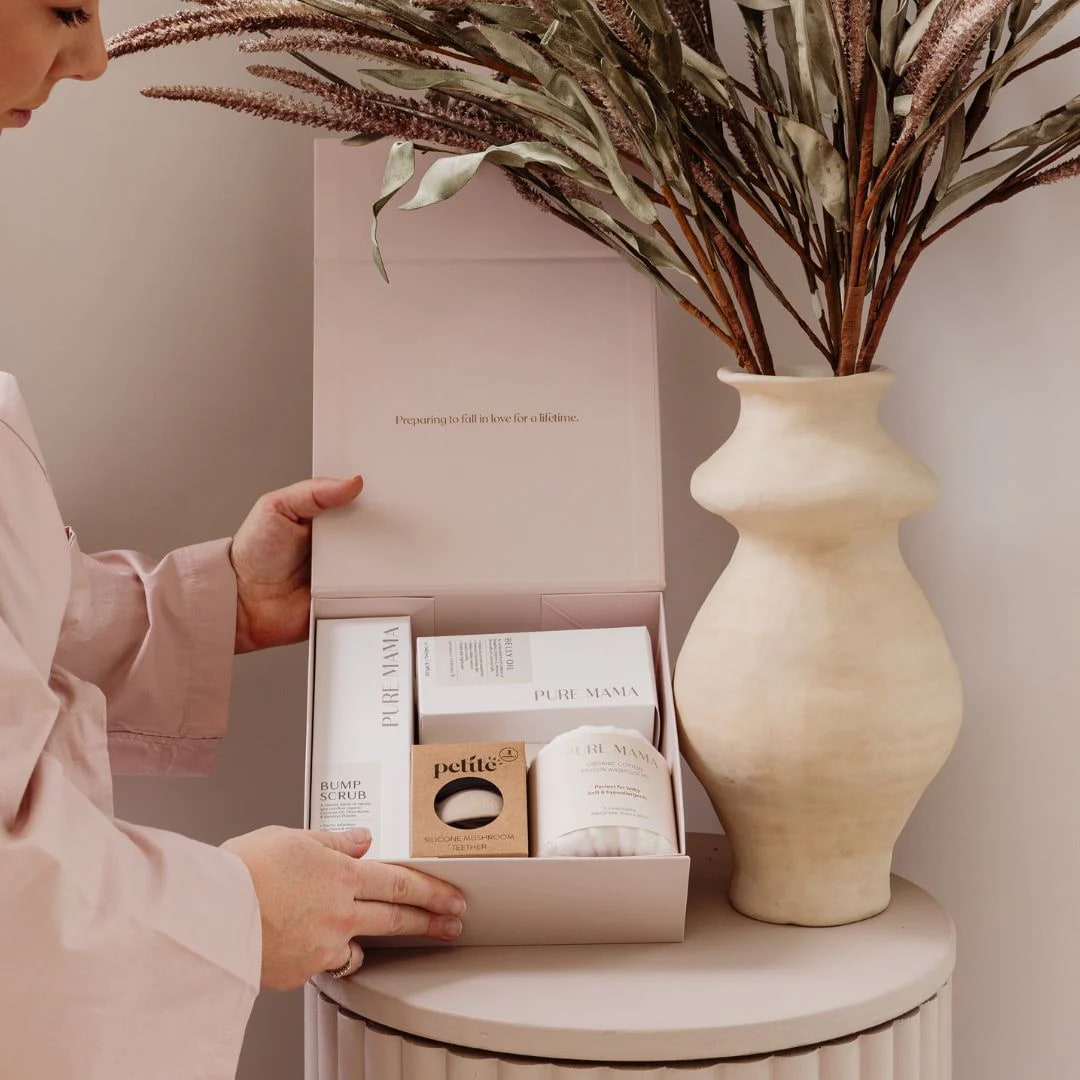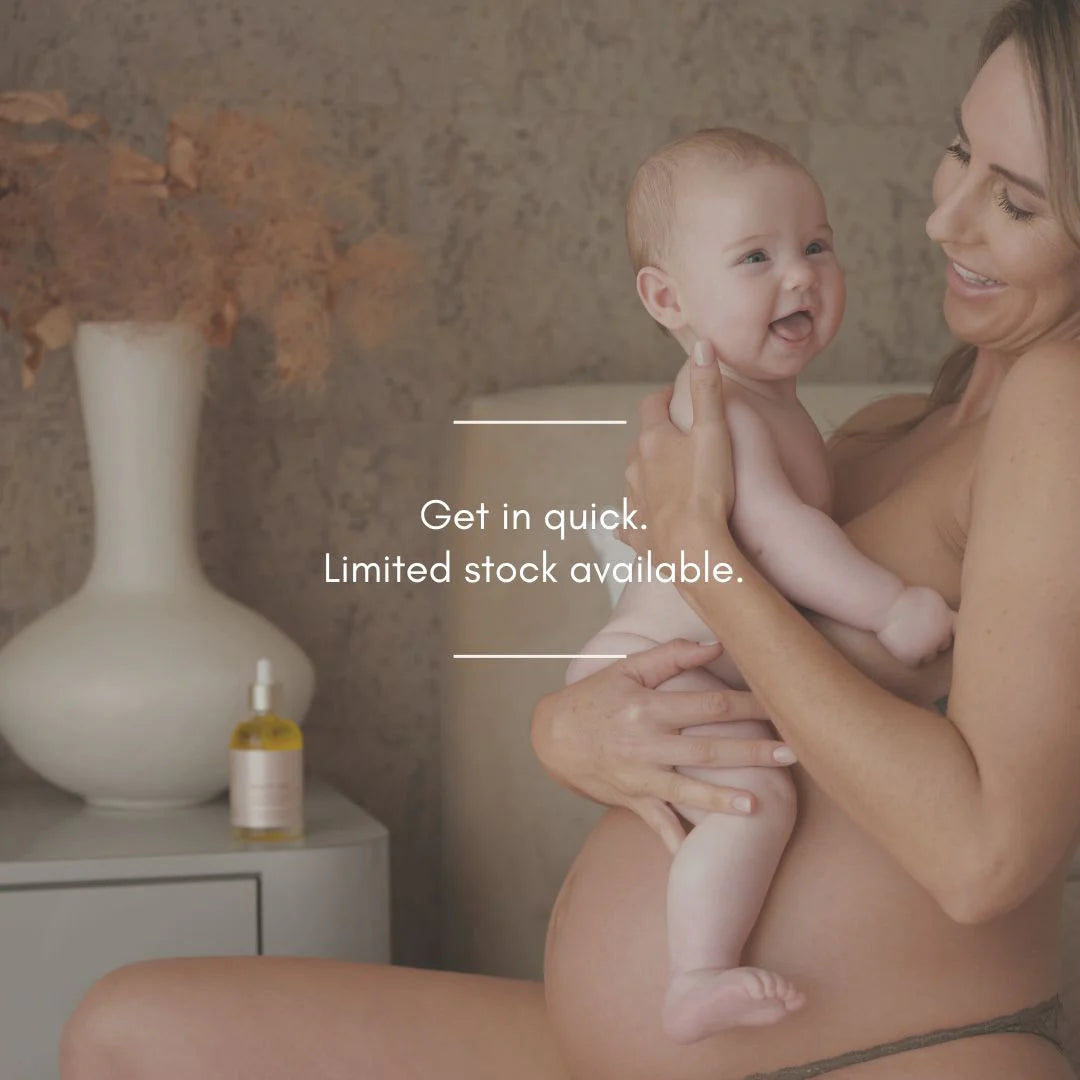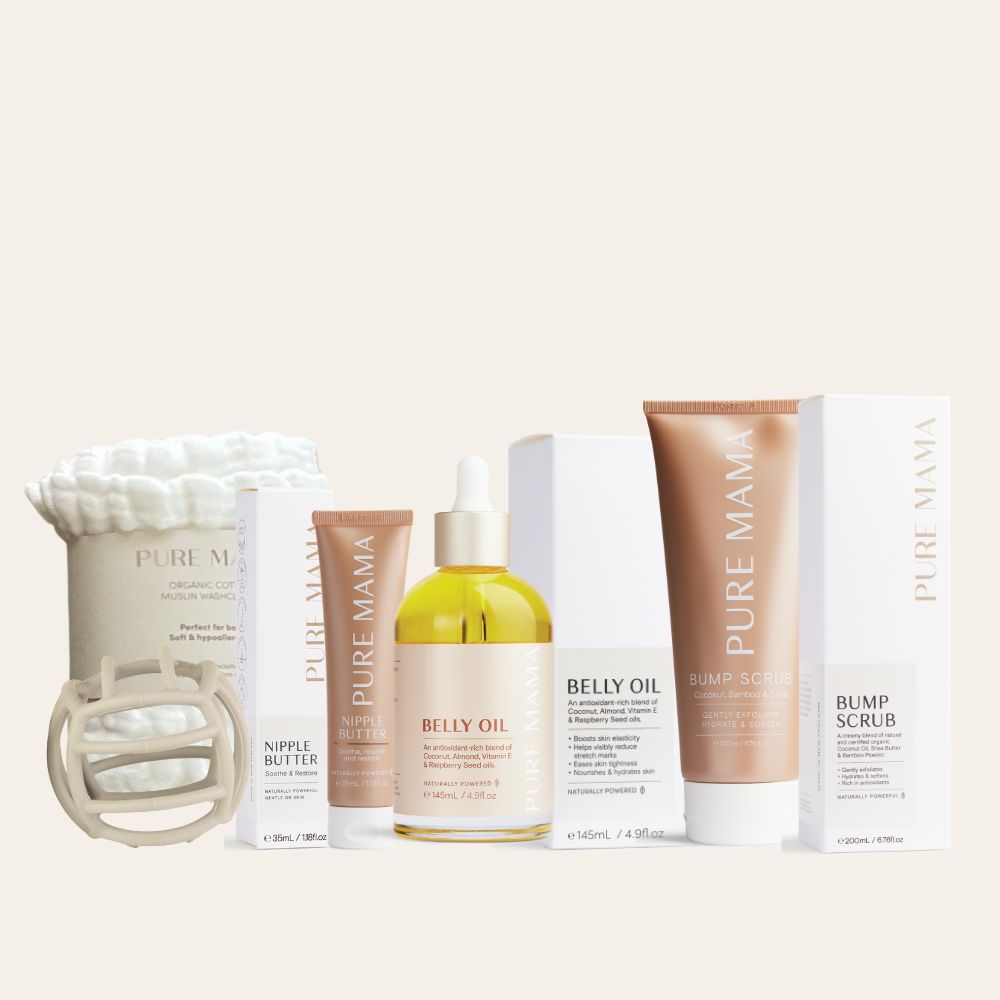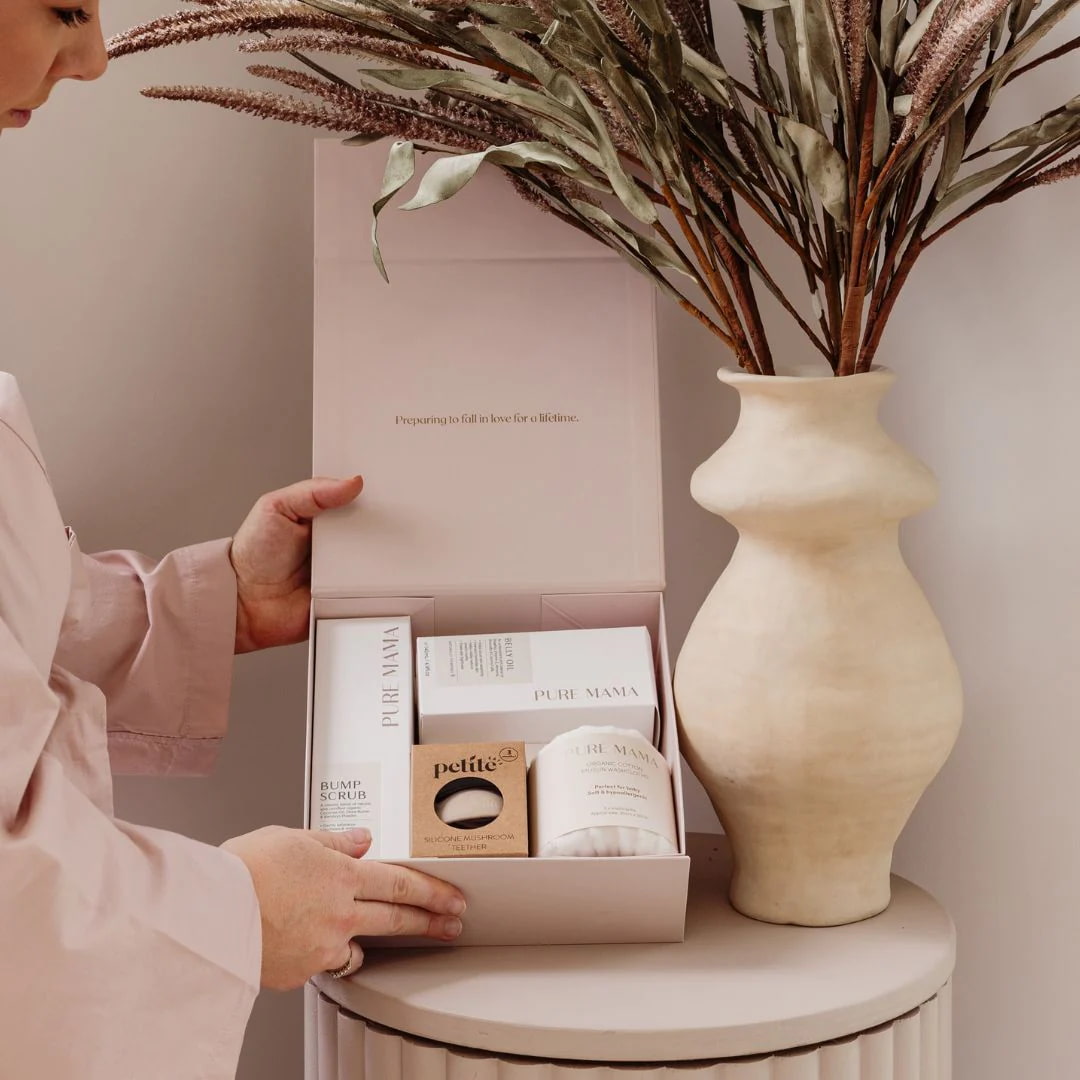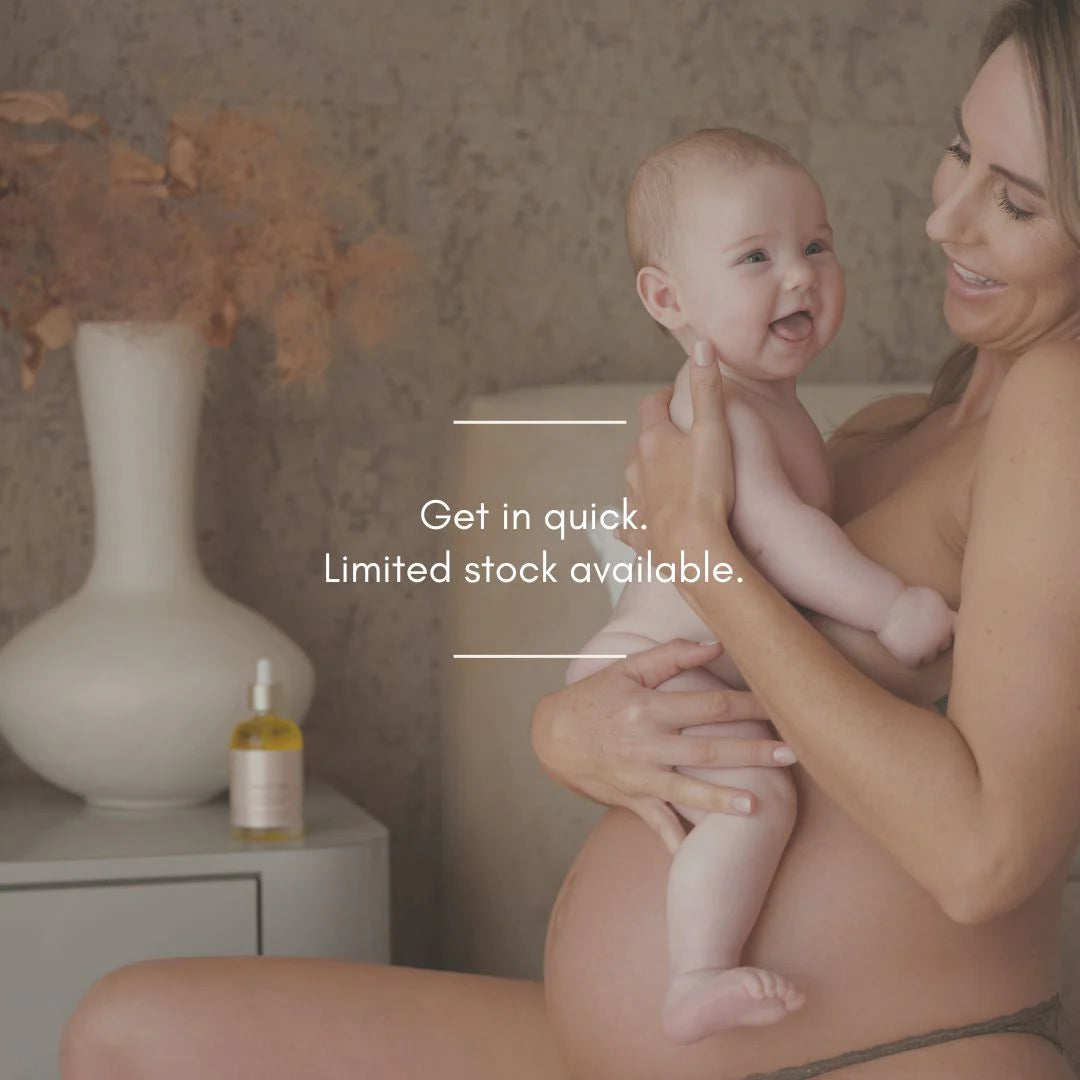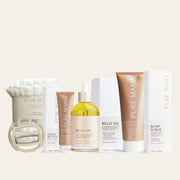Mama and Baby Set
Mama and Baby Set
SKU:PMMABS-3
In stock
Couldn't load pickup availability
Overview
Overview
LIMITED EDITION
This exclusive set combines three of Pure Mama’s bestselling skincare essentials for pregnancy and postpartum, along with two beautiful baby gifts to support you both through the early days and beyond. It’s the perfect way to nurture yourself or gift a loved one preparing for motherhood.
What’s Inside:
-
Belly Oil – A deeply hydrating blend of Rosehip, Vitamin E, Almond, Avocado and Coconut oils to support skin elasticity and help prevent the appearance of stretch marks. Ideal for daily use from the first trimester.
-
Bump Scrub – A creamy exfoliator made with organic Coconut Oil, Bamboo Powder, and ground Pumice to gently smooth and nourish your growing bump. Best used before applying Belly Oil.
-
Nipple Butter – A rich, all-natural balm formulated with Kawakawa, Marshmallow Root, Calendula, Coconut Oil, and Shea Butter to soothe and restore sore, cracked nipples.
Plus, receive two free baby gifts:
-
3 Organic Cotton Muslin Washcloths
-
1 Silicone Teething Ball
Carefully curated to support both mama and baby, this limited edition set helps you feel prepared, nurtured, and pampered every step of the way.
Technical Specification
Technical Specification
User Guide
User Guide
Delivery and Returns
Delivery and Returns
- Delivery: Free within NZ on orders over $100 (excluding bulky items) or $8 standard shipping
- Returns: Accepted within 14 days of receipt with proof of purchase
- Some items are excluded from returns including sale items, hardware, car seats, prams, monitors and personal items - please click here for the full list.
Share this product
Recently Viewed Products
Related Blogs
Tips for Planning a Baby Shower
Planning a Baby Shower? Here’s What to Keep in Mind 🎈🍼 Your little bundle is on the way, and you’re starting to think about planning a baby shower... how exciting! Whether you're organising it yourself or handing the reins to a trusted friend or family member, here are a few practical tips from the team at Dimples to help you get started (and enjoy the process too!). Set the date 🗓️ First things first - let’s lock in a date. Somewhere around the 7-month mark is a great time to host your shower. It gives you a nice buffer before baby arrives, and time afterward to sort through gifts and plan what else you might need. When it comes to timing, think about the style of event you’re going for. Is it a brunch with bubbles? A mid-afternoon tea? Three hours is a good ballpark to aim for — just enough time to relax and celebrate without anyone feeling rushed. Sort the guest list ✉️ There are no rules here — it’s entirely up to you who you’d like to share the day with. It could be a small group of close friends, a wider celebration with extended whānau, or even something co-ed with kids in tow. 💡 Tip: Give guests around five weeks’ notice to RSVP. That way, there’s plenty of time for people to plan (and pick a thoughtful gift!). A fun trend that’s growing in popularity is the Baby-Q — a relaxed afternoon BBQ where friends and family bring a plate and celebrate outdoors with the parents-to-be. Easy, casual, and no balloon arches required. Choose a theme (or don’t!) 🎉 You don’t need to go all out — unless you want to. Soft colours, simple tableware, a few bunches of flowers, and a cake can be all you need to make it feel special. That said, if you’ve been dreaming of a balloon garland or photo wall, go for it! Just keep in mind you’ll be the one packing it down at the end… or enlisting a very helpful friend 😉 Plan your catering 🍰☕️ Food is always a highlight, so think about what your guests might be expecting based on the time of day. A mid-morning gathering could be light and lovely with fresh fruit, muffins, and a hot cuppa. A midday shower might lean more toward grazing boards and savoury bites. If your guest list is small, you might feel happy preparing the food yourself. For a bigger crowd, consider asking a few friends to bring a plate — or treat yourself and hire a caterer so you can relax and enjoy the moment. Gift planning made simple 🎁 One of the loveliest parts of a baby shower is the chance for your people to help you prepare, with practical, beautiful gifts you’ll genuinely use. We recommend making a list of the essentials you’re still needing, and thinking about how you’d like to share that with your guests. Some people prefer a wishlist, while others like to keep it open-ended. 📝 Check out our Dimples Gift Registry — it’s an easy way to select what you need and share it with guests, no awkward asking required. You can also use our baby essentials checklist to make sure you haven’t missed anything. Most importantly… enjoy it! 💛 This is a celebration of you, your baby, and this incredibly special moment in your life. Whether it’s big or small, fancy or casual — surround yourself with people who lift you up, wear something that makes you feel good, and enjoy a slice of cake (or two). You deserve to be celebrated.
Learn morePregnancy Stages - Third Trimester
Can’t wait to meet you! Here’s what happens during your third trimester of pregnancy. You’re on the home stretch! It’s your third trimester, the final stage of your pregnancy, marked from week 29 to 40 (or even week 42 or 43, if you go over!) Anything uncomfortable that started getting niggly in the second trimester will continue, and probably get worse. You can expect a bunch of others to join the party, too! The good news is that it’s now possible for your baby to survive outside of the womb with some medical help, and every day that passes it’s getting stronger – something you’ll sure feel as it begins walloping you. This growing little person is now taking up more space, which pushes your internal organs up into your ribs, presses on your bladder and makes digestion difficult. You may get breathless and need to pee a whole lot more often. This is totally normal and will go away almost the second the baby is born. As your due date approaches, your body also begins getting ready for birth. The baby will start sitting lower in your belly, and your cervix will begin to thin and soften, which can feel like period cramps. You may also begin to feel Braxton Hicks, which are like tiny contractions and make your whole belly go rock hard. What happens to your body? This is the month of big physical changes on the outside for you-you'll look really, obviously pregnant, and begin to feel heavy and slow. Sleeping may also get harder – the weight of your belly means sleeping on your back is uncomfortable (and even dangerous), while side sleeping may feel more comfortable with a pillow between your knees and another under your belly. Here are some other things you may experience • Swollen feet, ankles, face or fingers. If you puff up suddenly or gain weight quickly, call your doctor – it could be a sign of pre-eclampsia, which is serious. • Constipation • Hemorrhoids • Tender breasts, which may begin making colostrum (pre-milk) • A popped-out belly button • Shortness of breath • Heartburn • Difficulty sleeping What’s going on in there? At 29 weeks, your baby is pretty much fully formed but is still busy getting everything into working order. Weighing in at about 1kg, and 38.5cm long, your baby’s soft bones are getting harder, with more calcium deposits. The brain is also fired up with neurons, gaining folds as it gets more complex. At 33 weeks, and kicking up a storm, your baby is 1.5kg and is losing living space by the day. Your baby is gaining about 200g a week, filling in that wrinkled skin The eyes can now open and close, but the lungs are still not quite ready yet. Even so, your baby has begun practicing breathing, by inhaling amniotic fluid. The fine covering of hair is now beginning to fall off, but many babies are born with much of it – and it falls off completely after birth. Your 36-week baby is counting the days until you finally get to meet. In the meantime, it’s in there packing on the pounds. The vernix, that waxy coating, is thickening and your active wee one is almost certainly pummeling you from within – you may even be able to tell whether that bump in your belly is a foot or a hand. At 40 weeks, your baby has organs that all work on their own and is technically ready to come out – although many babies stick around for two or three weeks longer. As your due date approaches, your baby will (hopefully) move its head down, facing backward. This is the ideal (but not the only) birth position. While you’re pregnant it can feel like a never-ending journey, and then suddenly you meet that little person you’ve been carrying for close to ten months. The range of emotions you might feel at this point is enormous – the first days with your new baby can be exhilarating, exhausting, heartbreaking and utterly wonderful all at the same time. You might suddenly see your pregnancy as a strange dream that happened to someone else! Getting ready for a baby? Click here to view our newborn essentials checklist.
Learn morePregnancy Stages - Second Trimester
Hello in there! Here’s what happens during your second trimester of pregnancy. The second trimester, marked from weeks 13 to 28, is often when pregnant women feel at their best. The major developments in your baby’s growth have slowed, which means the hormones (and all the horrible symptoms!) tend to ease now, too. Your baby bump will be popped out – so people stop wondering if you’ve just been eating too much cake – and you can also begin to feel a bit more reassured that your pregnancy will be viable. It’s extremely unusual to miscarry after week 12, which is why many parents wait until the second trimester to announce their impending addition to the family. Your baby is busy refining the developments made in the first trimester, which means you’ll still feel reasonably light and mobile. The second trimester is arguably the most exciting period in pregnancy. On top of feeling a lot better, you’ll also begin to see obvious signs of life. Some women feel movement as early as 13 weeks, but some don’t feel those first flutters until closer to 25 weeks. It all depends on your baby’s positioning, and where your placenta is. It’s in the second trimester that you’ll have scans that will tell you your baby is growing as it should, and, if you like, what sex it is. While the external sex organs are more clearly male or female now, scans can get it wrong – it’s not unheard of for parents to take home a little girl when they were expecting a boy (and vice versa!) What happens to your body? While your body is saving up all the really big changes until the third trimester, you’ll still notice a big shift. Here are some symptoms you may experience: Feeling achy in your back, tummy, groin, or thighs Stretch marks on your tummy, breasts, thighs, or bum Darkening of the areola (skin around your nipple) Development of the linea nigra – a line on your skin running from belly button to pubic hairline Patches of darker skin on your cheeks, forehead, nose, or upper lip Numb or tingly hands Itchy tummy, palms or bottoms of the feet. If this is combined with fatigue, nausea and yellowed skin, call the doctor – it could be your liver. Swollen feet, ankles, face or fingers. If you puff up suddenly or gain weight quickly, call your doctor – it could be a sign of pre-eclampsia, which is serious. The good news is that this is the trimester for the famous pregnancy glow. If you’re lucky, you might notice your hair getting lush and shiny, your nails growing faster, and your skin looking radiant. Not too bad right? Remember to treat yourself kindly – lots of good food, sleep and gentle exercise. You may notice feeling a little slower, or short of breath now, too – this is normal. Listen to what your body is telling you and try not to push yourself too hard. What’s going on in there? At 16 weeks, your baby is about 11.5 cm long and weighs a hefty 85 grams. This trimester is all about putting the finishing touches on its little work of art. The bones and muscles are still forming and the skin appears – it’s nearly transparent. Your baby will also be making its first poo! This is called meconium and develops in your baby's intestinal tract. The sucking reflex is working overtime, practising for the breast or bottle. Whether or not you can feel it, your baby is also getting frisky in there, kicking arms and legs, and swimming around in that still-roomy sack. At 20 weeks, the way your baby is measured changes. Before, your baby was measured from head to bum – it’s hard to measure those tiny legs when they’re all tucked up. At 20 weeks, people generally begin measuring foetuses from head to heel – so it can seem your baby has stretched from 15cm in week 19 to 25cm in week 20. Your baby’s skin is now covered by fine, feathery hair, called lanugo, and a waxy protective coating called vernix. Other hair comes in too – eyebrows, lashes and the first tufts up on top. Your baby can swallow, and also has working ears – you may notice your baby’s movements respond to sound. By 24 weeks, your baby is over halfway done – and babies born at this stage have even been known to survive, with a lot of medical help. There’s still plenty more left to do, though. Your baby needs to fatten up, and still has important elements developing: bone marrow begins to make blood cells, taste buds, footprints and fingerprints form, and sex organs are all present and accounted for. Your baby’s lungs are formed, but still don’t work. What happens next? Read about your third trimester.
Learn moreWhy Buy New Zealand Made Clothes?
From garments more well-travelled than most of us to clothing produced in factories not quite up to scratch – the backstory of what we buy has become an increasingly hot topic. Keeping shopping habits local is an easy way to not only do your bit for the environment but also support the New Zealand economy and the people who live here. Better still, buying New Zealand-made no longer means compromising on quality or choice – in fact, it’s typically quite the opposite! Do it for the birds and the bees (literally) The environmental impact of clothing sourced overseas is huge. Buying local often means reducing ecologically unfriendly packaging, and will certainly cut out vast amounts of fossil fuels in transport. Clothing made in New Zealand also complies with strict guidelines, which is a big win for the environment in an industry that is notoriously hard on the planet – no pesticide and fabric-dye-filled runoff contaminating water supplies here thanks! Feelgood tip – swap those well-travelled goods with locally-made merchandise. Fast fashion or future-friendly? The days of patching worn jeans and sewing up holes in socks are long gone – popping to the shops for a wallet-friendly replacement is just too easy. But with prices so low, something’s got to give – whether it’s the quality of raw materials, worker conditions, or the standard of the finished product. This fast-fashion movement ironically has you popping to the shops for replacements a whole lot more often! All this disposable fashion also becomes a major landfill problem. Synthetic fabrics are much cheaper to produce (they make up about 60% of a typical closet) and can go on to live hundreds of years after parting ways with your wardrobe. On the flip side, buying New Zealand-made means these items live up to local production standards, and are far more likely to survive playground adventures and multiple trips through the washing machine. They might even look good enough to pass on to family or friends once you’re done with them – recycling at its best! Feelgood tip – invest in quality, locally made items that can be passed on. Guilt and hassle-free shopping Shop-a-holics rejoice! If you’re buying locally produced goods, pat yourself on the back for your contribution to the local economy. You’re supporting fair, local employment and helping to keep New Zealand businesses alive and able to compete with the big guys. Shop-a-holics rejoice some more! If you’re buying locally produced goods and have accidentally bought the wrong size for your little one, it’s as easy as popping into a store or a local phone call to fix your problem. Local businesses are usually happy to help (as each customer is important) whereas it’s likely you’re literally one in a million for big global companies. Even finding contact details can be a challenge! Feelgood tip – shopping local simply supports New Zealanders. Dimples' does it differently No compromises here, just adorable, high-quality clothing, using high-quality raw materials, produced by fairly treated Kiwi workers! Our commitment to the environment hasn’t changed as the business has evolved and grown, and neither has our commitment to our workers. All Dimples clothing is made here in New Zealand from locally sourced merino (or from our neighbouring Australian sheep) and pure organic certified cotton (to ensure the impact of cotton farming is minimal). We don’t have a huge factory producing our clothing – instead, our expert sewers work from their homes. It’s essentially a scaled-up version of the small home workshop where it all started. The end result is hard-wearing, long-lasting clothing – that stays looking super cute for longer. Feelgood tip – buy New Zealand made.
Learn more

